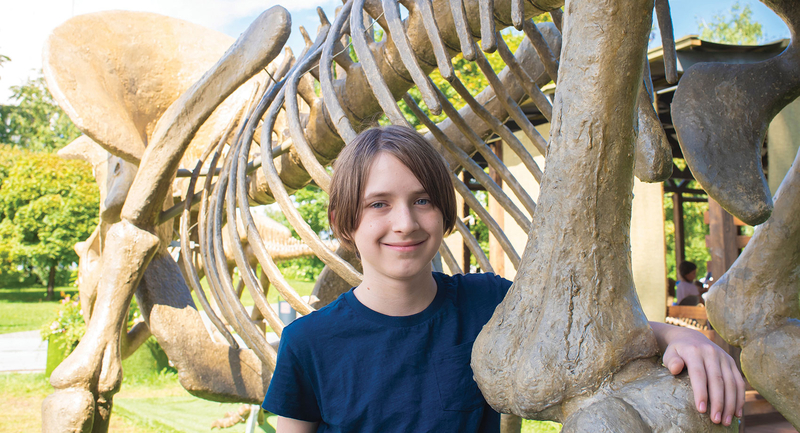Young faces are turned toward 8-year-old Elena. Their eyes are alert; they're waiting to hear what she has to say. Someone has just asked her why she really likes the book One Tiny Turtle (Candlewick, 2001) by Nicola Davies. Elena turns to page 6 and says, "Listen," as she reads the first sentence. "Far, far out to sea, land is only a memory, and empty sky touches the water." Her teacher, Ms. Ancova, can feel the magic of the sentence as Elena reads it.
Both Elena and Ms. Ancova anticipate the next question a student asks: "Why did you like that sentence?"
"I can see it in my mind," Elena replies, "the sky touching the water, and then, 'land is only a memory.' That really makes us understand how long it's been since that turtle has been on land."
Ms. Ancova is delighted that Elena is both visualizing images and appreciating writer craft. She makes a note to add a discussion of figurative language to her writing craft lessons and then goes back to listening to her students.
"I agree with you, Elena," states Jacob. "I like how the author makes us see the turtle's size. When the turtle is a baby, she says it's 'not much bigger than a bottle top.' And then when the turtle is about two, she says it's 'bigger than a dinner plate.'"
"And then," adds Kiah, "on page 21, when the turtle is over 30, the author says, 'She's big as a barrel now.'"
Thinking Like a Scientist
"Do turtles get bigger than a barrel? How long do they live, anyway?" wonders Marcos.
"I want to know that, too," Elena adds. "And I wonder how we know that a turtle grows up and returns to lay its eggs on the exact same beach where it was born. I mean, was someone there on the beach when a baby turtle came out of the egg and then somehow followed the turtle for years in the sea?"
Not only is Elena looking at text through a literary lens, but she is also bringing a scientific eye to it. Ms. Ancova always seems to be short on time to devote to science and social science in her 3rd grade class, so when a text appears during language arts time that can serve as a springboard to scientific or historical investigation, she seizes on that link. She says, "You know, both Marcos and Elena have a scientific inquiry. Marcos wonders how long loggerhead turtles live, and Elena wonders how we actually know that loggerheads return to the exact same beach where they were born to deposit their eggs. Both Elena and Marcos have turned their wondering into a scientific question."
"How will you go about answering your questions, Marcos and Elena?" queries Ms. Ancova.
"Well," says Elena. "I think I'm going to start by going to National Geographic's Web site.…"
In her research, Elena will discover that there is some doubt whether all loggerheads undertake this round-trip swim. She will be fascinated to learn that scientists track turtles by putting a beeping radio transmitter on their shells, which enables them to track the turtles by satellite. She may wonder whether they do this with other animals—and that will lead to new questions. She may wonder, too, whether the beeping is loud and bothers the turtles. She may imagine different tracking devices, maybe ones that she will invent someday.
Why a Disciplinary Lens?
Elena views text through disciplinary lenses. Such specific focusing and refocusing gives a depth to comprehension that more generic comprehension strategies may not provide. Although Elena can apply commonly taught strategies like visualization, prediction, or summarization, her deep engagement with the text comes from the disciplinary focuses of thinking like a scientist and thinking like a writer.
Much like a photographer changing lenses on a camera, Elena can home in on a specific literary device or question an author about his or her scientific evidence. Like the photographer, however, Elena—like all readers—can only focus well on one thing at a time. Ms. Ancova knows this, too, so she will often tell her students which lens they might consider for a specific text. When a text lends itself to a disciplinary view that they have discussed in class, she will encourage students to listen to or read the text with that focus in mind.
Before the class read One Tiny Turtle, Ms. Ancova explained that they were going to read a text written by a writer who uses lots of great images and that because the author is a zoologist, she includes scientific statements in her books as well. Ms. Ancova encouraged her students to think alternately like a scientist and like a writer as they read this book.
Viewing a text from a disciplinary perspective does not compensate for lack of vocabulary or conceptual knowledge that can quickly deter comprehension. It does, however, give the reader an idea of how to proceed when there is a roadblock. This is one reason that taking a disciplinary stance is recommended for teachers working with English language learners (Brock, Lapp, Salas, & Townsend, 2009).
Take Jenny, a 2nd grader, who could decode text considerably above grade level but whose reading comprehension was limited by her oral vocabulary (Juel, 1994). Jenny was interested in reading about rocks. Yet she was stymied when she encountered statements like, "There are various minerals in granite." She acknowledged, with considerable frustration, "I don't know much about rocks. I wouldn't know granite if I sat on it."
Jenny might not be so defeated if she had a way of thinking through this scientific subject matter. If she knew that observation might help her, she might seek out a photograph of granite or, better yet, find a rock sample. She might stare at a piece of granite and notice in it the shiny reflections of bits of translucent quartz, the flakes of black mica, and the creamy pink specks of feldspar. Even if she could not name these minerals, she could see how granite was composed of them. She might then wonder why these minerals adhere to one another. What force in nature could twist and hold them together? What force creates that glasslike quartz? Wonder, question, observe, think, question.…
There are two crucial reasons to include disciplinary frames in our instruction. One relates to reading comprehension: Disciplinary habits of mind can extend students' reading comprehension by providing scaffolds for thinking. If a student knows that studying the natural world entails careful observation and thinking, then the student is more likely to observe and think about what he or she sees or to wonder about the causes of particular phenomena.
If a student knows that scientific claims involve careful collection of evidence, he or she is more likely to ask for evidence from those who make scientific claims rather than accept those claims at face value. Indeed, students who question and challenge one another for evidence in their text discussions typically acquire the habit of asking questions as well as the expectation that they will continually learn new things (Resnick & Nelson-LeGall, 1996). Of course, what counts as evidence depends on the discipline. In providing literary evidence, it is acceptable to say how words make you feel. But in science, feeling will not get you far.
The second reason to support a disciplinary stance is because of technology. No longer do students jump to a set of printed encyclopedias; rather, they jump on the Internet. To understand how to evaluate all the information that is readily available online, students need to know the standard for evidence in a given arena. How, for example, will a student judge whether an Internet entry about loggerhead turtles reflects someone's desire to save a given stretch of coastline (as admirable as that motive might be) or is based on scientific evidence? Understanding how to think like a scientist, to think like a writer, and to think like a historian can provide students with direction as they read particular texts.
Thinking Like a Writer
In Mr. Salazar's 2nd grade classroom, the students have been studying narrative in their reading and writing. Today, as they think about how authors write their leads—their opening sentences— Mr. Salazar and his students revisit a read-aloud book, Too Many Tamales (Putnam, 1996), by Gary Soto. The class has already taken time to delight in the rich illustrations, feel the suspense of the dramatic plot, and respond to the texts as readers. Now the class rereads the lead, which Salazar has written on chart paper: "Snow drifted through the streets, and now that it was dusk, Christmas trees glittered in the windows." Students talk in pairs about what they notice and then share their comments with their classmates:
"You can tell what time of year it is and where you are," says Cerise.
"Yeah," says Robert, "it tells the setting."
"But it doesn't just say 'It was Christmas,'" adds Maya. "You can see the place because he describes what it looks like."
The class reads the excerpt again, and students point out the descriptive language, such as the snow drifted and the trees glittered. Mr. Salazar then helps students connect their observations to the writer's purpose. "Why might Gary Soto have begun his book with this description?" Mr. Salazar wants his students to understand that writers make composing decisions all the time—and that they do this with their audience and their purpose in mind.
The students decide that beginning a story with a description of a setting helps readers know where the story takes place and enables them to imagine the scene. Next, Mr. Salazar asks the students to give this type of lead a name—they decide to call it a "descriptive setting lead." He knows that building a shared vocabulary for discussing craft will help his students talk about and use crafting techniques (Pritchard & Honeycutt, 2007). He also understands that although getting students to notice craft is a good start, he will need to provide more instruction to help these young writers use the techniques they notice (Hillocks, 1987).
In subsequent lessons, he will provide opportunities for students to try this kind of lead for their own purposes and audiences. He might organize inquiry activities to help students think about describing scenes using sensory detail (Smith & Hillocks, 1989). He might model the strategy of visualization to develop setting, thinking aloud as he visualizes the scene of a narrative he is writing. Or he might teach a technique, showing how he revises his lead to use vivid verbs, as Soto does (Graham, 2006).
As Mr. Salazar's class continues its study of narrative, the students will notice all kinds of things about texts. They will talk about the foreshadowing in the lead of Anthony Browne's Piggybook(Dragonfly Books, 1990); the short, suspenseful sentences in Donald Crews'sShortcut (Greenwillow Books, 1996); and the simile in Jane Yolen's Owl Moon (Philomel, 1987). They will map out the structures of the narratives they read and notice how characters often change through the events in the plot. And they will begin to notice the craft they study in other books they read.
Thinking like writers can support reading comprehension in a several ways. Students become more attuned to writing craft—craft that is closely tied to the meaning of the text. For example, students who have studied foreshadowing are more apt to notice it in their own reading and can use it to support their predictions. Moreover, when students learn how to read closely, they learn a whole new way to talk about and appreciate texts. They see the value of lingering with a text, rereading to appreciate its literary qualities.
Thinking like a writer also supports the development of critical literacy. Frequent discussions that speculate about the author's purpose and audience help students realize the intentionality behind the texts they read. For example, a 6th grade class might read and write feature articles. They might discover that authors of these articles frame their topics in persuasive ways. They might also learn some techniques of persuasion, such as the strategic use of an emotionally appealing anecdote or alarming statistics.
Young readers who are aware of such strategies are better equipped to critique the texts they encounter. As our students move into adolescence and adulthood, they are exposed to more and more texts that aim to persuade them to buy, vote, or think in a particular way. Thinking like a writer can help students critically navigate these texts.
Thinking Like a Historian
We often associate history with memorizing important dates in singsong rhymes, doing a project on a famous American, or enacting a fun simulation of Colonial days. But learning history can also be an opportunity to practice reading behaviors that can transfer into real-world situations.
Stacie, a 7th grade language arts teacher who teaches a class period of history, is dismayed by the textbook's dry treatment of the U.S. Constitution. She wants her students to appreciate the importance and relevance of this document. So she finds stories of students denied their First Amendment rights and teaches a successful unit. Her students are emotionally invested in the tales of children who were affected directly by the Constitution.
Stacie values her students' personal responses and helps them relate their experiences to the texts, but she struggles with connecting her strengths in teaching reading to the discipline of history. What is new for Stacie, and for most of us who still think of history as learning about what happened in the past, is an understanding that the practice of history is a profoundly literate activity that has an important place in the school curriculum.
History is distinctive among the disciplines in seeking out many sources of information and wrestling with their contradictions and problems to tell a compelling narrative about a human event. Historians are experts at synthesizing huge amounts of texts. But how can the complex reading behaviors of a professional historian help improve a 7th grader's understanding of the world?
First, historians rarely learn from textbooks. We must acknowledge the limitations of the textbooks and nonfiction trade books that are the bulk of our school texts. The reality is that teachers can no longer control the amount or quality of information that students encounter. As Wineburg and Martin (2004) so vividly claim, "Ask any middle schooler with a research project how to spell the word library, and you'll get a six-letter response: G-O-O-G-L-E" (p. 43). And herein lies the danger. When a student searches for information on how Barack Obama got elected, for example, many of the Web sites listed contain varying degrees of bias and error. None of them even attempts to answer the question of how such a historic event happened. How can we even begin to help students decipher these results?
We can teach students that texts that deal with historical events often have real authors—as opposed to the faceless authors of textbooks, whose chief purpose is to write engaging, informative, and coherent text. Real authors have motivations for writing, and those motivations affect the credibility of their words. Consideration of the author's perspective, in historians' language, is called sourcing. Sourcing is the first and most instinctive reading move that historians make—and that students often don't make (Wineburg, 1991).
In this information age, students cannot wait until they are adults to acquire this skill. We can begin this conversation by providing even young students with texts that have a point of view and a visible author. Understanding who the author is and why he or she is taking this point of view is just as important as understanding what the author is saying.
In the instance of the student who searches online for information about how Barack Obama got elected, the historically minded student would make a point of noticing that one of the first Web sites retrieved—"Witness the death of journalism!" it exclaims—is authored by a filmmaker selling an inflammatory documentary about "media malpractice." When reading a textbook passage about the causes of the American Revolution or conflicting editorials about whether the United States should continue to fight in Afghanistan, the historically trained young reader would know that rarely are such complex events a simple story of good versus evil or right versus wrong. This reader would actively seek out more information to attain a more nuanced understanding.
It may be messy, long, and difficult, but the act of sifting through puzzling, conflicting, and biased texts should constitute at least part of a student's experience. This is the everyday work of the historian.
Of course, historians—like all good readers—also predict, reread, self-monitor, and so forth. But a distinctive trait of the discipline is the ability to synthesize vast amounts of text into a cohesive narrative, which is precisely the kind of critical thinking that we want our students to do. Historians are experts at corroborating information across different kinds of texts and perspectives. From them, we can learn how to help students think flexibly about multiple sources of information.
Start Young
We should cast a disciplinary lens over most texts—even when we're reading these texts with young children. Consider how a kindergarten teacher planted the seed for scientific reasoning, including the process of looking at data and forming hypotheses, while her students were reading the predictable text in Amy Casey's little book, Can You Find It? (Modern Curriculum Press, 1997).
On each page is a colored photo that shows an animal camouflaged in its natural surroundings. Underneath each photo appears the text, "Can you find the _____?" with the appropriate animal's name included (cat, frog, fox, and so forth). A striped house cat blends into the light and dark patterns of the foliage around it; a green frog perches on a green leaf; a white Arctic fox stands on snow. The teacher asks her students, "Why do you think the fox is white? Why do you think the frog is green? Why is the cat brown with black stripes? What is the big idea here?"
As a teacher, how might you decide which lens to adopt for a text? Take into account the message in the text and the vocabulary load. Think about what students might discuss. Clarify the discipline involved and the thinking specific to that discipline. Give students the opportunity to look at texts through the three useful lenses of science, writing, and history.









